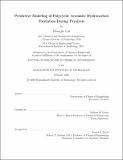Predictive modeling of polycyclic aromatic hydrocarbon formation during pyrolysis
Author(s)
Liu, Mengjie,Ph. D.Massachusetts Institute of Technology.
Download1237265734-MIT.pdf (5.852Mb)
Other Contributors
Massachusetts Institute of Technology. Department of Chemical Engineering.
Advisor
William H. Green.
Terms of use
Metadata
Show full item recordAbstract
Polycyclic aromatic hydrocarbons (PAHs), large molecules comprised of multiple aromatic rings like anthracene or pyrene, are a notable intermediate and byproduct in combustion or pyrolysis of hydrocarbon fuels. On their own, they have been shown to pose a significant health risk, with certain PAHs being linked to increased cancer risk in humans. In addition, PAHs are known to play an important role as building blocks towards larger particles, known as soot or black carbon, which contribute a significant fraction of atmospheric PM₂.₅ pollution (particulate matter with diameters under 2.5 [mu]m). These particulates pose additional health risks and can also contribute to global climate change via radiative forcing. This motivates interest in understanding the chemical pathways leading to the formation of these PAHs, which could inform better models to predict PAH emissions and optimize methods to reduce their formation. This thesis presents methods to improve the capabilities of automatic mechanism generation software in modeling the complex chemistry involved in PAH formation. In particular, it focuses on the Reaction Mechanism Generator (RMG) software, an open-source package developed primarily in Python. RMG automatically identifies species and reactions which are relevant at conditions of interest to aid construction of detailed mechanisms, but it has not been previously applied for PAH chemistry. To do so, new algorithms were developed to improve treatment of aromaticity and chemical resonance to better reflect the true behavior of molecules within the limitations of programmatic representations. The effect of polycyclic ring strain on parameter estimation was also investigated, highlighting challenges in capturing 3D conformational effects using the existing estimation frameworks and methods to address them. These improvements to fundamental algorithms play an important role in how thermochemical and kinetic parameters are estimated. The combined utility of these developments is demonstrated by the generation of a detailed mechanism for modeling PAH formation up to pyrene in acetylene pyrolysis, which represents an important milestone in RMG capabilities. Analysis of the model provides insight into the relative contributions of various PAH formation pathways, revealing that hydrogen abstraction, acetylene addition pathways are the key contributors to PAH formation in this system.
Description
Thesis: Ph. D., Massachusetts Institute of Technology, Department of Chemical Engineering, February, 2020 Cataloged from student-submitted PDF of thesis. Includes bibliographical references.
Date issued
2020Department
Massachusetts Institute of Technology. Department of Chemical EngineeringPublisher
Massachusetts Institute of Technology
Keywords
Chemical Engineering.